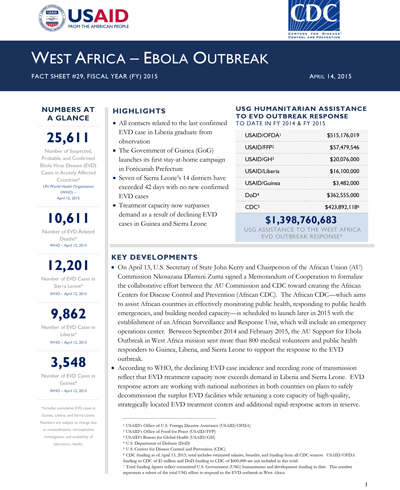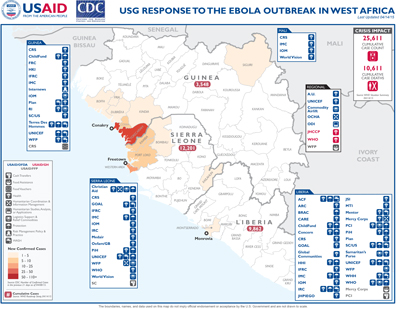April 14, 2015
HIGHLIGHTS
Ebola Response
Visit our main West Africa Ebola Outbreak page to learn more about how we're responding to the West Africa Ebola outbreak, and what you can do to help.
- All contacts related to the last confirmed EVD case in Liberia graduate from observation
- The Government of Guinea (GoG) launches its first stay-at-home campaign in Forécariah Prefecture
- Seven of Sierra Leone’s 14 districts have exceeded 42 days with no new confirmed EVD cases
- Treatment capacity now surpasses demand as a result of declining EVD cases in Guinea and Sierra Leone
WEST AFRICA EBOLA OUTBREAK FACT SHEET #29 (FY 15) ![]() (pdf - 302k)
(pdf - 302k)
KEY DEVELOPMENTS
- On April 13, U.S. Secretary of State John Kerry and Chairperson of the African Union (AU) Commission Nkosazana Dlamini Zuma signed a Memorandum of Cooperation to formalize the collaborative effort between the AU Commission and CDC toward creating the African Centers for Disease Control and Prevention (African CDC). The African CDC—which aims to assist African countries in effectively monitoring public health, responding to public health emergencies, and building needed capacity—is scheduled to launch later in 2015 with the establishment of an African Surveillance and Response Unit, which will include an emergency operations center. Between September 2014 and February 2015, the AU Support for Ebola Outbreak in West Africa mission sent more than 800 medical volunteers and public health responders to Guinea, Liberia, and Sierra Leone to support the response to the EVD outbreak.
- According to WHO, the declining EVD case incidence and receding zone of transmission reflect that EVD treatment capacity now exceeds demand in Liberia and Sierra Leone. EVD response actors are working with national authorities in both countries on plans to safely decommission the surplus EVD facilities while retaining a core capacity of high-quality, strategically located EVD treatment centers and additional rapid-response actors in reserve.
REGIONAL
During the week of March 30 to April 5, West African countries reported the lowest weekly total of confirmed EVD cases since the third week of May 2014, according to WHO. Guinea recorded 21 confirmed EVD cases compared to the previous week’s 57 cases. In Sierra Leone, EVD case incidence decreased for the fifth consecutive week, with nine confirmed EVD cases. Liberia maintained zero confirmed EVD cases during the same period. In addition, no new health workers contracted EVD; the cumulative total of EVD cases among health workers since the start of the outbreak remains at 861.
West Africa Ebola Map #29 April 14, 2015 ![]() (pdf - 513k)
(pdf - 513k)
Liberia
The Government of Liberia (GoL) has not reported a confirmed EVD case in Liberia since March 20. The last confirmed case died at the Monrovia Medical Unit (MMU) on March 27 and was buried at the Disco Hill national burial site on March 28. As of April 10, CDC reported that all contacts of the confirmed case had graduated from observation. The 42-day period required for Liberia to be considered free of EVD began on March 29, according to WHO.
On April 8, a team of U.S. Public Health Service (USPHS) Commissioned Corps personnel working at the MMU began training 13 staff from the GoL-managed ELWA 2 EVD treatment unit (ETU) in Montserrado County. USPSH is training the ELWA 2 staff on infection prevention and control (IPC) procedures and best practices in clinical care, nursing, and pharmacy and laboratory management, as well as appropriate use and management of specialized MMU equipment. Upon request from the ELWA 2 staff, USPHS plans to conduct additional training sessions in the coming week.
On April 13, USAID/OFDA partner Mercy Corps and its lead technical sub-partner Population Services International launched the second national conference focused on the Ebola Community Action Platform (E-CAP)—a USAID/OFDA-funded nationwide social mobilization campaign that utilizes a consortium of primarily local non-governmental organizations (NGOs) to train and mobilize community members. Mercy Corps expects at least 75 local and international organizations to participate in the two-day conference, which includes sessions on lessons learned during the EVD response and the role of social mobilization in the restoration of health care services, among other topics. The first E-CAP conference occurred in early February and focused primarily on lessons learned and strategies for improving the program. To date, USAID/OFDA has provided Mercy Corps with $12 million to implement E-CAP. The program targets approximately 2 million people throughout Liberia with EVD awareness and prevention messages.
Sierra Leone
WHO reported that, between March 30 and April 5, nine EVD cases were confirmed in the Sierra Leone districts of Kambia, Port Loko, Western Area Rural, and Western Area Urban, which includes the capital city of Freetown. As of April 7, both Kono and Tonkolili districts had reached 42 days with no new EVD cases. Of Sierra Leone’s 14 districts, seven have now exceeded 42 days with no new cases, according to the Sierra Leone National Ebola Response Center (NERC).
The Sierra Leone President’s Delivery Team on Transition and Recovery convened a workshop in Sierra Leone’s capital city of Freetown on April 8 and 9. The event included Government of Sierra Leone (GoSL) ministries, donors, UN agencies, and non-governmental organizations, and featured four simultaneous sessions focused on the president’s core sectors for post-EVD transition: health, education, private sector recovery and growth, and social protection. Supported with funding from the UK Department for International Development, the workshop aimed to specify transition plans, including responsible actors, timelines, budgets, and targets.
The International Organization for Migration (IOM) led an interagency assessment team comprising CDC and UN Development Program representatives to Bombali District on the Sierra Leone–Guinea border between April 8 and 10. In the town of Makeni, the assessment team met with members of the Bombali District Ebola Response Center (DERC) and other stakeholders to examine health systems and border operations in the district and identify key challenges. The assessment team also visited an official border crossing—currently closed due to EVD-related restrictions—in the village of Simbeckom. Noting the amount of informal border crossings occurring in the area and the weak levels of EVD preparedness and sensitization in the local communities, IOM plans to provide IPC training to border, immigration, and health officials prior to an expansion of border management activities in Bombali.
Members of the USG Disaster Assistance Response Team (DART) also visited Bombali on April 10–11 to meet with partner Christian Aid and discuss ongoing social mobilization activities. With USAID/OFDA support, Christian Aid is coordinating with local organizations on community engagement and raising awareness of EVD prevention best practices. In addition to Christian Aid, USAID/OFDA supports social mobilization in Bombali through Catholic Relief Services (CRS) and, through funding to IOM, the NGO World Hope. Partners report that social mobilization coordination—previously lacking—at the district level has improved, and the DERC coordinator emphasized the importance of continued collaboration among all social mobilization actors. DART staff also visited Bombali’s village of Pate Bana, where Christian Aid’s activities have engaged community members, and reported that people in Pate Bana were knowledgeable of EVD and receptive to outreach activities.
Guinea
While EVD surveillance is improving in Guinea, unknown chains of transmission could present lead to EVD cases in the coming weeks, WHO reports. During the week of March 30 to April 5, seven of 19 confirmed deaths from EVD were identified post-mortem as compared with 15 of 35 confirmed deaths from EVD during the previous week, according to WHO. Approximately 48 percent of EVD-confirmed cases among registered contacts—a slight decrease from 53 percent during the previous week.
As part of the 45-day health emergency period, the GoG launched its first stay-at-home campaign in Maférinya village, Forécariah Prefecture, on April 12. Between April 12 and 15, the campaign aims to visit approximately 50,000 households across the prefecture to detect new EVD cases and inform community members about the new emergency health mandate. The GoG plans to use the Forécariah campaign as a pilot program to develop strategies for reaching communities in other EVD-affected prefectures in coming weeks.
During the National Ebola Coordination Cell meeting on April 13, the GoG announced three new confirmed EVD cases and 17 suspected EVD cases uncovered during the first day of the stay-at-home campaign. The GoG reported widespread community cooperation with the house-to-house teams.
PUBLIC DONATION INFORMATION
- The most effective way people can assist relief efforts is by making cash contributions to humanitarian organizations that are conducting relief operations. A list of humanitarian organizations that are accepting cash donations for disaster responses around the world can be found at www.interaction.org.
- USAID encourages cash donations because they allow aid professionals to procure the exact items needed (often in the affected region); reduce the burden on scarce resources (such as transportation routes, staff time, and warehouse space); can be transferred very quickly and without transportation costs; support the economy of the disaster-stricken region; and ensure culturally, dietary, and environmentally appropriate assistance.
More information can be found at:
- The Center for International Disaster Information: www.cidi.org or +1.202.821.1999.
- Information on relief activities of the humanitarian community can be found at www.reliefweb.int.
USAID/OFDA bulletins appear on the USAID website at what-we-









Comment
Make a general inquiry or suggest an improvement.